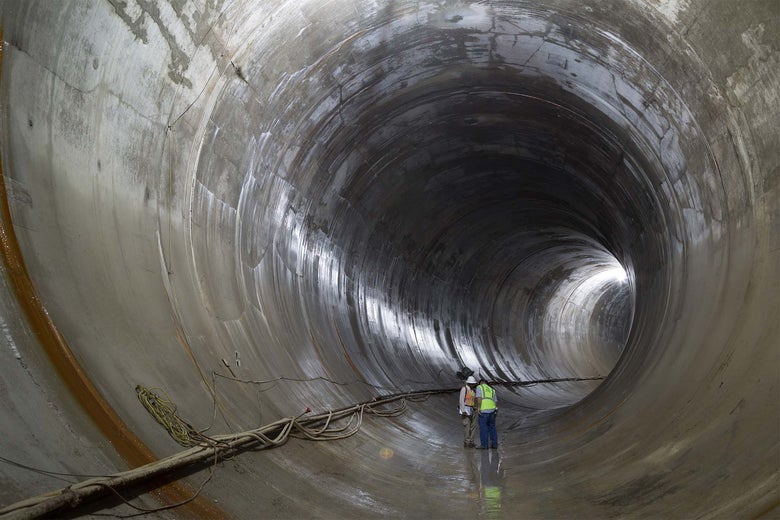Tunnel Vision
Chicago tried to dig its way out of urban flooding decades before climate change made it a national crisis. Did the city, and its imitators, pick the wrong solution?
Slate
Henry Grabar

Construction workers lean in to discuss the project over the noises echoing throughout the Deep Tunnel. Photos by David Schalliol.
"CHICAGO—That the Chicago River is reborn, that its tree-shaded promenades are thronged with strolling families, that new buildings turn toward the water and old buildings have opened new windows to face it, that people kayak in what was once an open cesspool in the middle of downtown—all of this is a point of pride here. People laughed when then-Mayor Richard J. Daley said in the ’70s that he’d one day like to see people grilling freshly caught fish on the river’s banks. Though it would have seemed insane in 1980 (or 1880), people do fish in the Chicago River today, and the number of species to be found here has multiplied tenfold in the past four decades."
That’s because Chicago built a second river, an infernal reflection of the first, tracing its course hundreds of feet below ground. On rainy days, this subterranean passage, a conduit that can hold more than 1 billion gallons of wastewater, welcomes a roaring torrent of shit, piss, and oily runoff from the downtown streets. This megasewer, a filthy hidden portrait to the Chicago River’s Dorian Gray, is dynamic enough to create its own wave action if not properly supervised. That’s what happened on Oct. 3, 1986, when a geyser blasted through a downtown street, lifting a 61-year-old woman’s Pontiac Bonneville into the air like a toy, nearly drowning the driver in dirty water."
"Altogether, 109 miles of subway-size tunnel lie beneath Chicago and its suburbs, covering more miles than the L, culminating in three suburban reservoirs (not the kind you drink from). This is the Deep Tunnel, formally the Tunnel and Reservoir Plan, and it may be the world’s most ambitious and expensive effort to manage urban flooding and water pollution. It is a project, in the visionary tradition of Chicago engineering, to bottle rainstorms."
Chicago tried to dig its way out of urban flooding decades before climate change made it a national crisis. Did the city, and its imitators, pick the wrong solution?
Slate
Henry Grabar

Construction workers lean in to discuss the project over the noises echoing throughout the Deep Tunnel. Photos by David Schalliol.
"CHICAGO—That the Chicago River is reborn, that its tree-shaded promenades are thronged with strolling families, that new buildings turn toward the water and old buildings have opened new windows to face it, that people kayak in what was once an open cesspool in the middle of downtown—all of this is a point of pride here. People laughed when then-Mayor Richard J. Daley said in the ’70s that he’d one day like to see people grilling freshly caught fish on the river’s banks. Though it would have seemed insane in 1980 (or 1880), people do fish in the Chicago River today, and the number of species to be found here has multiplied tenfold in the past four decades."
That’s because Chicago built a second river, an infernal reflection of the first, tracing its course hundreds of feet below ground. On rainy days, this subterranean passage, a conduit that can hold more than 1 billion gallons of wastewater, welcomes a roaring torrent of shit, piss, and oily runoff from the downtown streets. This megasewer, a filthy hidden portrait to the Chicago River’s Dorian Gray, is dynamic enough to create its own wave action if not properly supervised. That’s what happened on Oct. 3, 1986, when a geyser blasted through a downtown street, lifting a 61-year-old woman’s Pontiac Bonneville into the air like a toy, nearly drowning the driver in dirty water."
"Altogether, 109 miles of subway-size tunnel lie beneath Chicago and its suburbs, covering more miles than the L, culminating in three suburban reservoirs (not the kind you drink from). This is the Deep Tunnel, formally the Tunnel and Reservoir Plan, and it may be the world’s most ambitious and expensive effort to manage urban flooding and water pollution. It is a project, in the visionary tradition of Chicago engineering, to bottle rainstorms."
Click to read the rest of the article at:



No comments:
Post a Comment